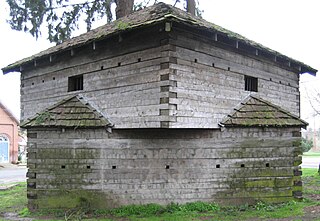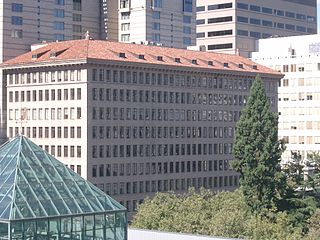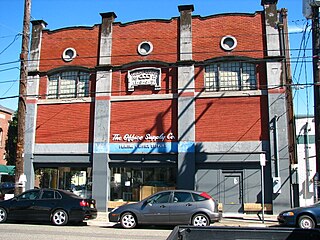
Fort Yamhill was an American military fortification in the state of Oregon. Built in 1856 in the Oregon Territory, it remained an active post until 1866. The Army outpost was used to provide a presence next to the Grand Ronde Agency Coastal Reservation. Several officers stationed at the United States Army post prior to the American Civil War would later serve as generals in that war.

The Pacific Building is a historic office building in downtown Portland, Oregon, United States. It has been listed on the National Register of Historic Places since March 5, 1992.

The Henry Weinhard Brewery complex, also the Cellar Building and Brewhouse and Henry Weinhard's City Brewery, is a former brewery in Portland, Oregon. Since 2000, it has been listed on the National Register of Historic Places. In that same year, construction began to reuse the property as a multi-block, mixed-use development known as the Brewery Blocks.

The Portland Hotel was a late-19th-century hotel in Portland, Oregon, United States, that once occupied the city block on which Pioneer Courthouse Square now stands. It closed in 1951 after 61 years of operation.

Minthorn Hall is an academic building on the campus of George Fox University in Newberg, Oregon, United States. Built in 1887, the hall was moved ten blocks to its current location in 1892. The three-story frame building is the oldest building on the campus of the school, and was the first building of the Quaker school. Future President Herbert Hoover may have briefly lived in the structure prior to its conversion to a school building. The hall was added to the National Register of Historic Places on June 13, 1997.

The Barber Block is a building complex located at the corner of Southeast Grand and Washington Streets in Portland, Oregon, listed on the National Register of Historic Places (NRHP). It was built in 1890 and listed on the NRHP in 1977. It is also located within the East Portland Grand Avenue Historic District.

The East Portland Grand Avenue Historic District, located in southeast Portland, Oregon, is listed on the National Register of Historic Places. The district includes approximately 20 city blocks on or near Southeast Grand Avenue on the east side of the Willamette River, roughly bounded on the south by SE Main Street, north by SE Ankeny Street, west by SE Martin Luther King Jr. Boulevard, and east by SE Seventh Avenue. Most structures in the district are commercial buildings rising two to three stories. Immediately to the west of the historic district is Portland's east side industrial area, and to the east are industrial and residential areas.

The William B. Holden House is a house located in southeast Portland, Oregon listed on the National Register of Historic Places. The property was deemed significant for its architecture, for its landscape architecture, and for its association with the life of Dr. W. B. Holden (1873–1955). The house was designed by architect Roscoe Hememway. The landscape architecture was designed by John Alexander Grant. The property included a rose garden.

The Portland Yamhill Historic District, located in downtown Portland, Oregon, is listed on the National Register of Historic Places.

The Stevens Building is a commercial and office building located in downtown Portland, Oregon, listed on the National Register of Historic Places. The 12-story building was designed by Whidden & Lewis. The design is similar to the Failing Office Building (1907) and Wilcox Building (1911), also by Whidden & Lewis. Construction began in August 1913 and was completed in 1914, with the building opening on May 1, 1914. The total construction cost was $375,000. The building is approximately 152 feet (46 m) tall.

The W. S. Salmon House in southeast Portland in the U.S. state of Oregon, is a 2.5-story apartment house listed on the National Register of Historic Places. Built in the Queen Anne style in 1890, it was added to the register in 1994.

The Alphabet Historic District, is a historic district in the Northwest District of Portland, Oregon which was listed on the National Register of Historic Places in 2000. It is 156.9 acres (63.5 ha) in area and includes 478 contributing buildings. It is roughly bounded by NW Lovejoy St., NW Marshall St., NW 17th Ave., W. Burnside St., and NW 24th Ave.

Hamilton Forbush "Ham" Corbett was a prominent Portland, Oregon businessman and in his younger years was a leading amateur American football player. He played college football for Harvard University and was a consensus first-team selection to the 1908 College Football All-America Team.
The Carroll Public Market, also known as the Yamhill Street Market, was a fresh produce market that operated for twenty years on the sidewalks of SW Yamhill Street between First and Fifth avenues in Portland, Oregon, during the early decades of the 20th century. The organizational structure of the market eventually included 212 stalls and over 400 vendors who offered pricing by negotiation. One writer characterized the atmosphere as "loosely organized chaos." The market was dissolved and replaced by the Portland Public Market in 1934.

The Yamhill River lock and dam was completed in 1900. It was built near Lafayette, Oregon, to allow better river transport on the Yamhill River from Dayton, to McMinnville, Oregon. While the Corps of Engineers had recommended against construction of the lock, it was built anyway, largely as a result of political effort by the backers of the project. For almost forty years prior to the lock construction there had been efforts made to construct a lock and dam on the Yamhill River.

The Great Fire of 1873 was a major fire which swept through the downtown of Portland, Oregon on August 2, 1873, destroying twenty-two blocks on the west side of the Willamette River, including along Yamhill and Morrison Streets. A mix of mansions, tenements, and commercial property were destroyed. Many businesses were not insured, and many others were only partially insured.

Willamette Block is an historic building in Portland, Oregon. The 1882 structures is part of the Portland Yamhill Historic District, which is listed on the National Register of Historic Places.

















